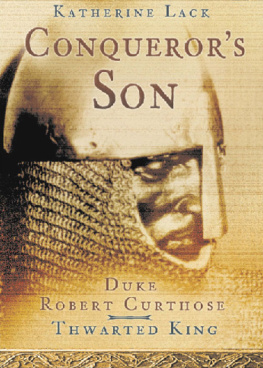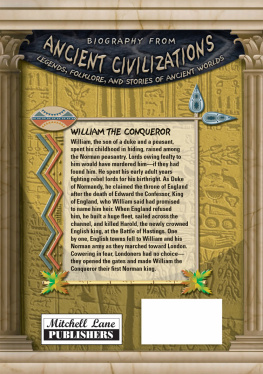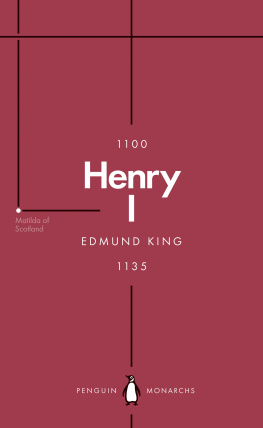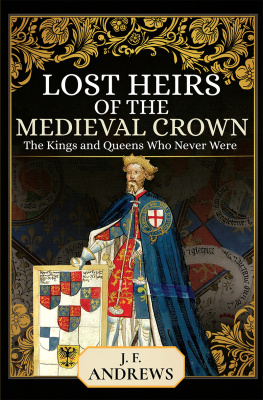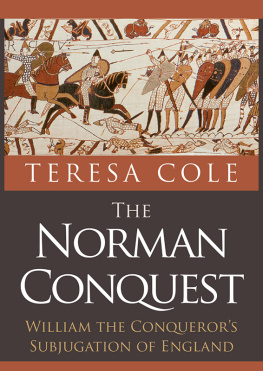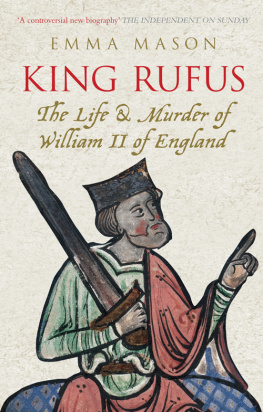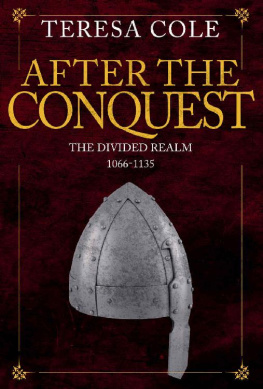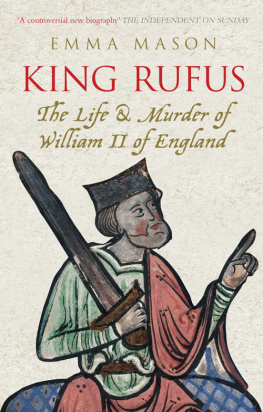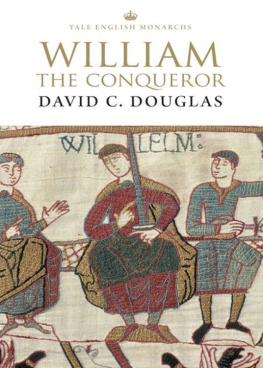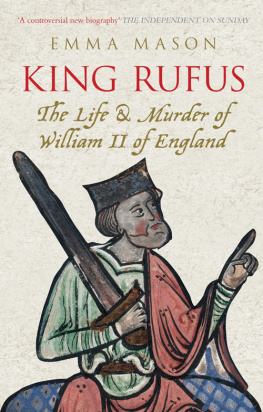C ONTENTS
This book arose from an M.Phil. thesis on the de obitu Willelmi and the 1087 Anglo-Norman succession. I must therefore begin by paying especial tribute to my supervisor for that degree, Nicholas Brooks, who led me gently along the sometimes convoluted paths of medieval scholarship until a presentable end product emerged. Without his help and support, the thesis, never mind this book, would not have been completed. I would also like to thank Steve Bassett and Elisabeth van Houts for their generous encouragement, and all those members of the Department of Medieval History at Birmingham University, sadly too numerous to mention, who have listened patiently to me over the last three years and have made many valuable suggestions and observations.
The town of Tinchebray held a splendid conference in September 2006, on the 900th anniversary of the battle at which Duke Robert Curthose was taken prisoner. Among the many people who attended, I would particularly like to record the assistance of Richard Barton, Matthew Bennett, Peter Damian-Grint, Hugh Doherty, Judith Green, Ann Nissen-Jaubert, Ian Peirce and Thomas Roche.
I am most grateful to the following for help with supplying illustrations: Ann Nissen-Jaubert, Ian Peirce, The Bridgeman Art Library, Mme Christle Potvin at the Seine-Maritime Archives, The British Library, Sonia Halliday Photographs, Mrs P. Hatfield and the Provost and Fellows of Eton College. Quotations from The Anglo-Saxon Chronicle, ed. D. Whitelock, D.C. Douglas and S.I. Tucker (Eyre and Spottiswoode, 1961), are reproduced by permission of Cambridge University Press; those from The Deeds of the Franks and the other Pilgrims to Jerusalem, ed. R. Hill (Nelson, 1962), are reproduced by permission of Oxford University Press. Quotations from Eadmers History of Recent Events in England: Historia Novorum in Anglia, trans. G. Bosanquet (Cresset Press, 1964), are reprinted by permission of the Random House Group Ltd. Quotations from C. Cahen, Orient et occident au temps des Croisades (Aubier Montaigne, 1983), are reproduced by kind permission of Flammarion, Paris. Quotations from William of Malmesburys The Gesta Regum Anglorum; The Charters and Custumals of Holy Trinity Caen; The Chronicle of John of Worcester; Henry, Archdeacon of Huntingdon: Historia Anglorum; The Gesta Normannorum Ducum; The Ecclesiastical History of Orderic Vitalis and The Letters of Lanfranc are all reproduced by permission of Oxford University Press.
Many people have helped with reading individual chapters, or with particular areas of expertise, most notably Deryn Chatwin, Peter Damian-Grint, Iestyn Daniel (who alerted me to the fact that a Welsh poem Curthose is reputed to have written at Cardiff is almost certainly an eighteenth-century forgery), Howard Edwards, Hugh Houghton, Graham Loud, Janet Maxwell-Stewart, Philippa Semper, Richard Sharpe, Chris Wickham and above all Matt Edwards, who read the entire typescript at very short notice, made pertinent comments throughout and yet remains on friendly terms with me. Inevitably, however, it is the home team who suffer the most, and it is to them that this book is dedicated to a husband who does not really like history that much, and a son who now knows far more about the de obitu than any 17-year-old should.
| AA | Historia Hierosolymitana Albert of Aachen (RHC Oc. 4) |
| Anna Comnena | The Alexiad of Anna Comnena, trans. E.R.A. Sewter (1969) |
| Annales Monastici | Annales Monastici, ed. H. Luard (5 vols; RS 36; 18649) |
| Anselms Letters | The Letters of Saint Anselm of Canterbury, trans. W. Frhlich (3 vols; 19904) |
| ASC | The Anglo-Saxon Chronicle, ed. D. Whitelock, D.C. Douglas and S.I. Tucker (1961) |
| B | Regesta Regum Anglo-Normannorum: The Acta of William I (10661087), ed. D. Bates (1998) |
| BD | Baldric of Dol: Historia Jerusalem Domini Baldrici Archiepiscopi (RHC Oc. 4) |
| DB | Domesday Book: History from the Sources, ed. J. Morris (197586) |
| F | Receuil des actes des ducs de Normandie de 911 1066, ed. M. Fauroux (1961) |
| FC | Fulcher of Chartres: Fulcherii Carnotensis Historia Hierosolymitana (PL 155; 1880) |
| GF | Gesta Francorum The Deeds of the Franks and the other Pilgrims to Jerusalem, ed. R. Hill (1962) |
| GND | The Gesta Normannorum Ducum , ed. E. van Houts (2 vols; 1992) |
| GR | The Gesta Regum Anglorum. The History of the English Kings of William of Malmesbury, ed. R.A.B. Mynors, R.M. Thomson and M. Winterbottom (2 vols; 1998) |
| HA | Henry, Archdeacon of Huntingdon: The Historia Anglorum. The History of the English People, ed. D. Greenway (1996) |
| HC | The Hyde Chronicle: Liber monasterii de Hyda, ed. E. Edwards (RS 45; 1886) |
| HN | Eadmers History of Recent Events in England: Historia Novorum in Anglia, trans. G. Bosanquet (1964) |
| HR | Symeonis Monachi Historia Regem, ed. T. Arnold (RS 75 ii; 1885) |
| JW | The Chronicle of John of Worcester , ed. P. McGurk (1998) |
| MGH | Monumenta Germaniae Historica |
| OV | The Ecclesiastical History of Orderic Vitalis, ed. M. Chibnall (6 vols; 196980) |
| PL | Patrologia Latina, ed. J.-P. Migne |
| PR 31 HI | The Pipe Roll for 31 Henry I (1929) |
| Prou | Receuil des actes de Philippe I , ed. M. Prou (1908) |
| PT | Petri Tudebodi de Hierosolymitana itinere (PL 155; 1880) |
| RA | Raimundi de Agiles Historia Francorum (RHC Oc. 3.i) |
| RC | Gesta Tancredi in Expeditione Hierosolymitana. Ralph of Caen (RHC Oc. 3.ii) |
| Regesta, i | Regesta Regum Anglo-Normannorum 10661100, ed. H. Davis (1913) |
| Regesta, ii | Regesta Regum Anglo-Normannorum 11001135, ed. C. Johnson, H.A. Cronne and H.W.C. Davis (1956) |
| RHC Oc. | Receuil des historiens des Croisades, Occidentaux |
| RHC Or. | Receuil des historiens des Croisades, Orientaux |
| RHGF | Receuil des historiens des Gaules et de France |
| RS | Rolls Series |
| Suger | The Deeds of Louis the Fat: Suger, trans. R. Cusimano and J. Moorhead (1992) |
| VCH | Victoria County History |
| Wace | The History of the Norman People: Waces Roman de Rou, ed. G. Burgess (2004) |
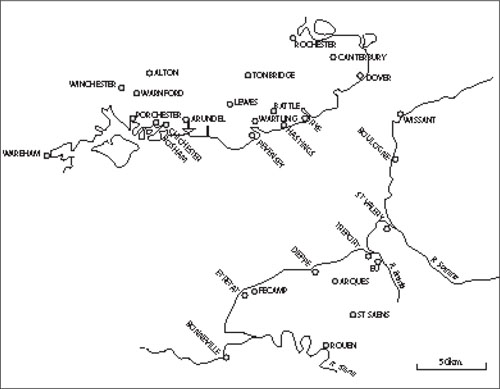
The eastern Channel coasts, c. AD 1100
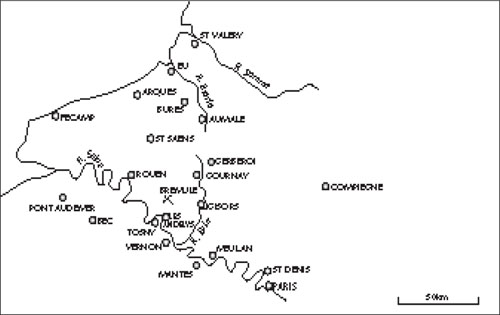
The Vexin
The following family trees are intended as a guide through the maze of relationships surrounding Robert Curthoses life. It should be noted, however, that they can be regarded only as approximate, owing to the paucity of evidence, the extreme complexity of some family alliances and the desperate parsimony of name choice at this period.
1. The Dukes of Normandy
2. The French Royal Dynasty
3. The English Royal Dynasty
4. The Counts of Flanders

